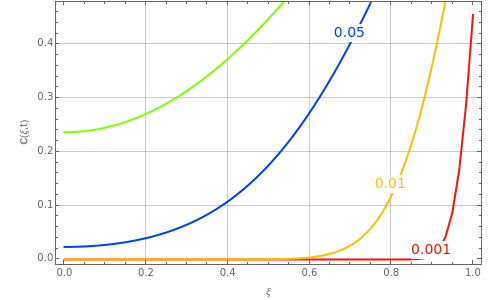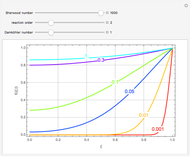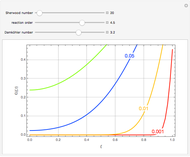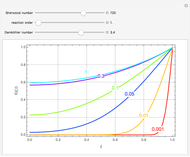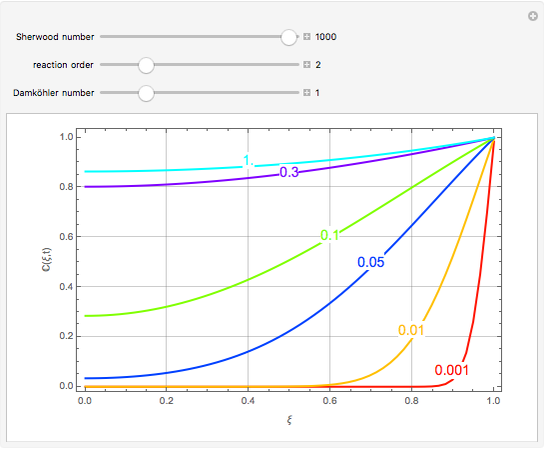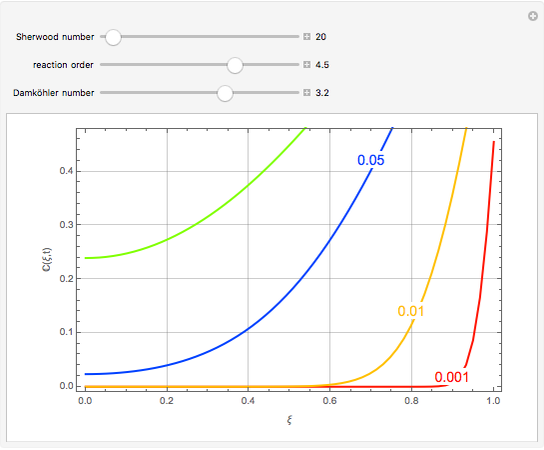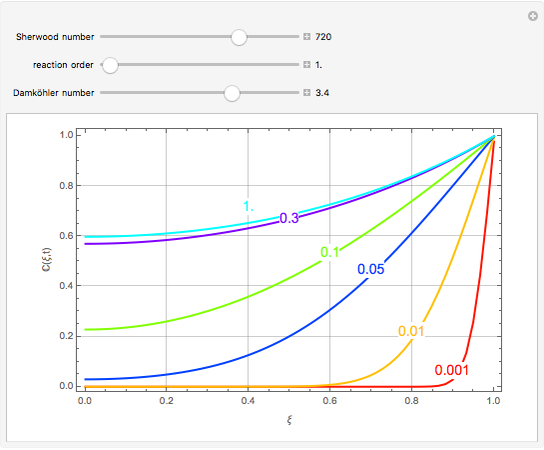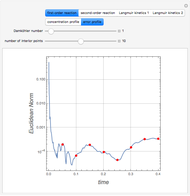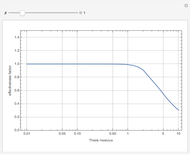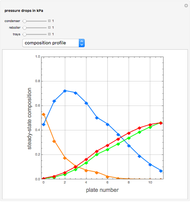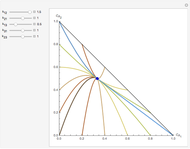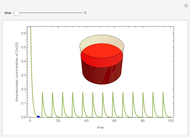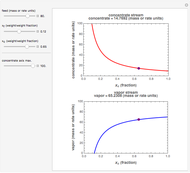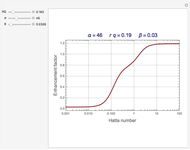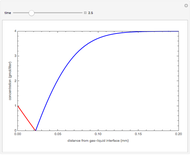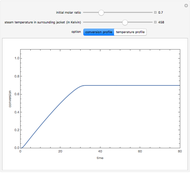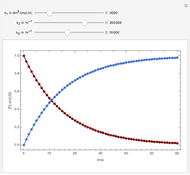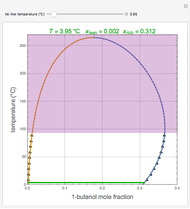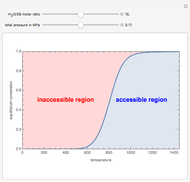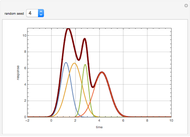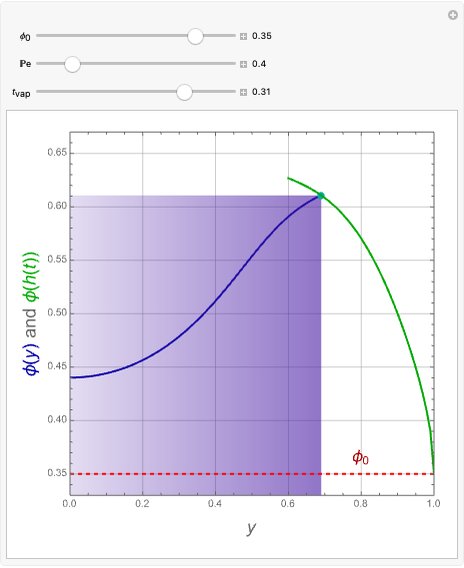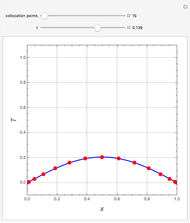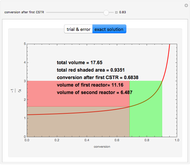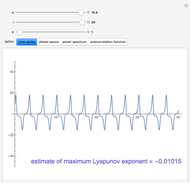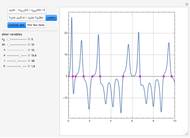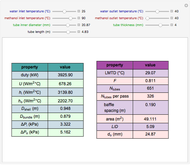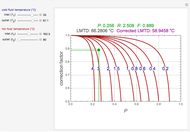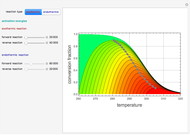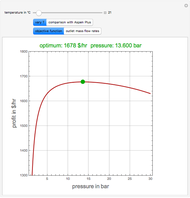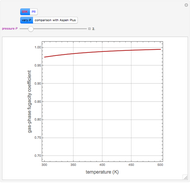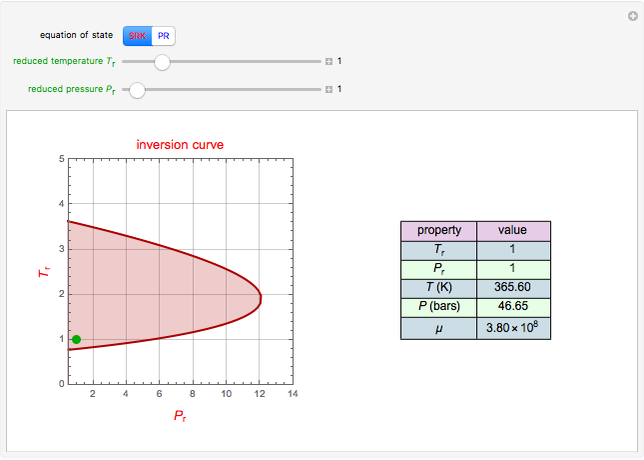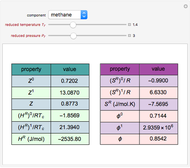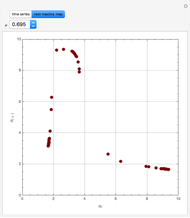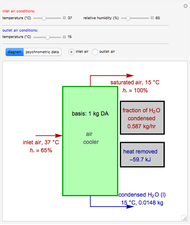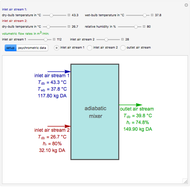The concentration of species  is taken to be a function of
is taken to be a function of  only. Here,
only. Here,  is the radial position,
is the radial position,  is the drop's radius,
is the drop's radius,  is the diffusion coefficient,
is the diffusion coefficient,  is the convective heat transfer coefficient,
is the convective heat transfer coefficient,  is the concentration of species
is the concentration of species  ,
,  is the reaction rate constant, and
is the reaction rate constant, and  is the reaction order. The boundary value problem is (BC means boundary condition, IC means initial condition):
is the reaction order. The boundary value problem is (BC means boundary condition, IC means initial condition):
 ,
,  ,
,
IC:  ,
,
BC1:  ,
,
BC2:  at
at  .
.
BC2 defines the mass transfer flux across the interface of the drop and  is the far field concentration.
is the far field concentration.
Dimensionless Form
For the analysis we define the following dimensionless variables:
 ,
,  ,
,  ,
,
where,  ,
,  , and
, and  are the dimensionless concentration, radial position, and time, respectively.
are the dimensionless concentration, radial position, and time, respectively.
In dimensionless form the PDE becomes:
 ,
,  (1)
(1)
IC:  ,
,
BC1:  ,
,
BC2:  at
at  .
.
The problem then depends on two dimensionless quantities:  (i.e. the Sherwood number for mass transfer) and
(i.e. the Sherwood number for mass transfer) and  (i.e. the Damköhler number).
(i.e. the Damköhler number).  represents the relative importance of convective mass transport to diffusional transport. When convective transport dominates diffusional transport (i.e.
represents the relative importance of convective mass transport to diffusional transport. When convective transport dominates diffusional transport (i.e.  ), the concentration gradients in the drop are negligible. For small Sherwood numbers, the concentration in the drop is governed by diffusional processes. When
), the concentration gradients in the drop are negligible. For small Sherwood numbers, the concentration in the drop is governed by diffusional processes. When  , one recovers the case when there is no reaction.
, one recovers the case when there is no reaction.
Numerical Analysis
We solve the dimensionless form of the problem using the method of lines. Note the problem is linear and the only issue we need to address is the apparent singularity at  . Evaluating the limiting behavior at
. Evaluating the limiting behavior at  shows that the appropriate equations are
shows that the appropriate equations are
 , for
, for  ,
,

 , at
, at  .
.
Finite Difference Operators for Spatial Derivatives
The central difference template for the spatial derivatives of our PDE at the  node is
node is
 ,
,  ,
,
 ,
,  ,
,
where we have defined the node spacing by:  .
.
For our problem, we subdivide the drop radius into a grid of  intervals such that the grid coordinates are
intervals such that the grid coordinates are  ,
,  where
where  . With this definition it follows that
. With this definition it follows that  and
and  .
.
The PDE can then be expressed as:
 (2)
(2)
 ,
,  (3)
(3)
Thus we have  equations in
equations in  unknowns. At
unknowns. At  we have the following BC:
we have the following BC:
 .
.
Approximating the spatial derivative with a central difference gives
 .
.
Solving for  gives:
gives:
 , (4)
, (4)
while at  we have
we have
 ;
;
a central difference formula gives
 , (5)
, (5)
where  is evaluated at
is evaluated at  . Thus equations (4) and (5) allow us to eliminate the fictitious nodes from equations (2) and (3) to give
. Thus equations (4) and (5) allow us to eliminate the fictitious nodes from equations (2) and (3) to give  equations in terms of
equations in terms of  unknown
unknown  values.
values.
This Demonstration plots the concentration profile versus the radial position,  , for several values of the dimensionless time,
, for several values of the dimensionless time,  . You can vary the Sherwood number, the reaction order (e.g.
. You can vary the Sherwood number, the reaction order (e.g.  is a first-order reaction), and the Damköhler number (e.g.
is a first-order reaction), and the Damköhler number (e.g.  or no chemical reaction, see the last snapshot). For large values of
or no chemical reaction, see the last snapshot). For large values of  , the boundary condition BC2 becomes
, the boundary condition BC2 becomes  .
.
[less]

 . Species
. Species  absorbs and diffuses into the interior of the drop and then reacts with the liquid. Assume that the kinetics for this reaction are
absorbs and diffuses into the interior of the drop and then reacts with the liquid. Assume that the kinetics for this reaction are  , where
, where  is the reaction order.
is the reaction order.